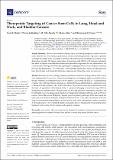Therapeutic Targeting of Cancer Stem Cells in Lung, Head and Neck, and Bladder Cancers
Author(s)
Mudra, Sarah E.; Sadhukhan, Pritam; Ugurlu, M. Talha; Alam, Shorna; Hoque, Mohammad O.
Downloadcancers-13-05098.pdf (14.91Mb)
Publisher with Creative Commons License
Publisher with Creative Commons License
Creative Commons Attribution
Terms of use
Metadata
Show full item recordAbstract
Resistance to cancer therapy remains a significant obstacle in treating patients with various solid malignancies. Exposure to current chemotherapeutics and targeted agents invariably leads to therapy resistance, heralding the need for novel agents. Cancer stem cells (CSCs)—a subpopulation of tumor cells with capacities for self-renewal and multi-lineage differentiation—represent a pool of therapeutically resistant cells. CSCs often share physical and molecular characteristics with the stem cell population of the human body. It remains challenging to selectively target CSCs in therapeutically resistant tumors. The generation of CSCs and induction of therapeutic resistance can be attributed to several deregulated critical growth regulatory signaling pathways such as WNT/β-catenin, Notch, Hippo, and Hedgehog. Beyond growth regulatory pathways, CSCs also change the tumor microenvironment and resist endogenous immune attack. Thus, CSCs can interfere with each stage of carcinogenesis from malignant transformation to the onset of metastasis to tumor recurrence. A thorough review of novel targeted agents to act against CSCs is fundamental for advancing cancer treatment in the setting of both intrinsic and acquired resistance.
Date issued
2021-10Department
Massachusetts Institute of Technology. Department of Electrical Engineering and Computer ScienceJournal
Cancers
Publisher
Multidisciplinary Digital Publishing Institute
Citation
Cancers 13 (20): 5098 (2021)
Version: Final published version
ISSN
2072-6694